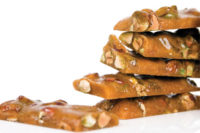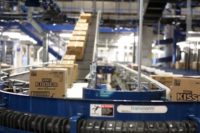The cremini, a three-layer chocolate that features two delicate slabs of gianduja chocolate sandwiching an inner chocolate paste of varying flavors, beckons memories of another era.
Invented in the late 1800s by Ferdinando Baratti and Edoadro Milano, the chocolate reflects the sensual and stylish elegance of the famous confectionery shop the two partners opened in Turin in 1875.
As one local newspaper wrote on the day of the shop’s grand opening: "In the new Galleria dell'Industria Subalpina, a splendid venue has opened, which, for its size, its wealth and quality of decoration, its stylish furnishings, and its exquisite and immense variety of products, rivals and even surpasses all others, both those of its own type and also the finest establishments of different sorts in Turin".
It was at this shop that that people came to sample Baratti & Milano’s confections, coffees, drinking chocolates, wines and spirits. And it was here that the cremini became a café favorite.
Thus, it should come as no surprise then that today’s creminis from Baratti & Milano impart that same sense of style, elegance and sensuality. But unlike the production methods used at the famed Baratti & Milano café back then, today’s creminis are produced using the latest technology available.
Renzo Pappa, the director of operations at the company’s chocolate and candy facility in Bra, Italy, oversees production at the 8,000-sq.-ft. plant. In fact, he’s done so for the past 20 years. Consequently, he’s particularly aware of the heritage involved with producing a broad range of Baratti & Milano products, from chocolate bars and eggs to creminis and gianduiottis.
Continued sales growth at Baratti & Milano over the past several years, particularly for the company’s cremini line, which is the best-selling item in its product portfolio, had prompted Papa to evaluate the possibility of replacing the existing production line with a new one.
The existing line was rated at 1,000 kilos per day, accompanied with a 10% waste ratio. For Papa, the new line not only had to boost output, but had to reduce waste. He also wanted minimal downtime during changeovers as well as the ability to use the line to produce different confections.
Papa's wish list might have proved a bit daunting to most equipment suppliers, particularly when applied to such a specialized piece of confectionery equipment as a cremini line.
A 20-year-old relationship with Bruno Porro, managing director of Tecno 3, simplified his quest. Porro, who’s helped supply Papa with a broad range of customized equipment — everything for a unit designed to feed raisins into truffles to chocolate holding tanks — embraced the challenge of the project.
As Papa explains, it took more than a year to develop the line, transferring his ideas onto paper, handing it over to Porro , who then — together with his team — engineered it into stainless steel confectionery processing line . The 60-meter long line features four sets of depositors and accompanying sets of cooling tunnels.
By doubling the width of the belt, increasing the line speed and expanding the cooling units, the output was increased threefold, to 3,000 kilos per day. In addition, during the final trimming stage involving vertical and horizontal cutting, excess product is automatically returned to the depositing hopper to be reworked.
In addition to being able to produce four-layered as well as three-layer cremini, the line can also be used for praline production. Changeovers take only 30 minutes, a key requirement for Papa, because the company produces eight different flavors. In addition, besides the traditional square format popular with cremini, the unit can also trim layers into rectangles.
After final cooling, the individual cremini pieces are fed into a Carle & Montanari wrapper, which operates at 385 pieces per minute.
The plant also houses two other chocolate lines: a hard candy/toffee line, and a panning department, which features four chocolate pans and three sugar pans. In addition to producing a broad range of chocolate bars (22 varieties), the company has had success with a line of wine-infused chocolate bars.
Focusing on local wine varieties from the Piedmont region, such as Barbaresco and Moscato, Papa was able to develop — in conjunction with Purro and Tecno-3 — a line of bars capable of having a 6% wine content.
“Traditionally, the wine content in a chocolate bar ranges between 2.5 to 3%, because of the amount of water in wine,” he says. “By emulsifying the chocolate, we can increase our percentage to 6%.”
Currently, 80% of the company’s sales are domestic, with the remainder coming from exports. As expected, Italian consumers favor traditional flavors, such as hazelnut and Amaretto, while foreign tastes are more adventuresome.
Papa, who also heads up product development, says the company typically brings out three new products annually. For 2013, however, Baratti & Milano will debut 12 new chocolates and eight candy items.
The company looks to debut a four-layer cremini product this year. In addition, its newly developed Sugar Flake mint underscores Papa’s broadbased knowledge within confections, not just chocolate.
The Sugar Flake is a hard candy, which after 24 hours of curing, contains a softer core, providing more textural variety as well as flavor. The process depends on adjusting temperature and humidity, which have an impact on the sugar graining process, Papa explains.
Such continued innovation at Baratti & Milano reflects the company’s heritage, which emphasized elegance and elan. But unlike the cafe, which relies on an opulent exterior, Papa’s expertise involves delving beyond the outside and into the inner sanctum, whereby one interweaves technology and automation with confectionery artistry and ingenuity.
In a way, Papa might be called the modern-day version of Italian poet Guido Gozzano, who spent innumerable hours at the Turin café 's in order to observe the gracious women, as he was "...in love with all the ladies eating pastries at the confectioners."
So inspired was Gazzano by the young women who "became girls again" when eyeing a tray of confections and pastries that in July 1907 he wrote a famous poem "Le golose" (Sweet-toothed women) at the Baratti & Milano confectionery shop.
So too, Papa, who’s inspired by the art of chocolate and candy making. Unlike Gazzano, Papa’s time is spent in the plant, gazing at process and products. Moreover, his masterworks are delectably edible.
At a glance: Baratti & Milano
Headquarters: Novi Ligure, Italy, division of Elah-Dufour
Plant: Bra, Italy (8,000-sq.-ft.)
Production lines: Three chocolate lines; one hard candy/toffee processing line; panning department (four chocolate pans, three sugar pans)
Employees: 18
Output: 7,000 kilos daily




















